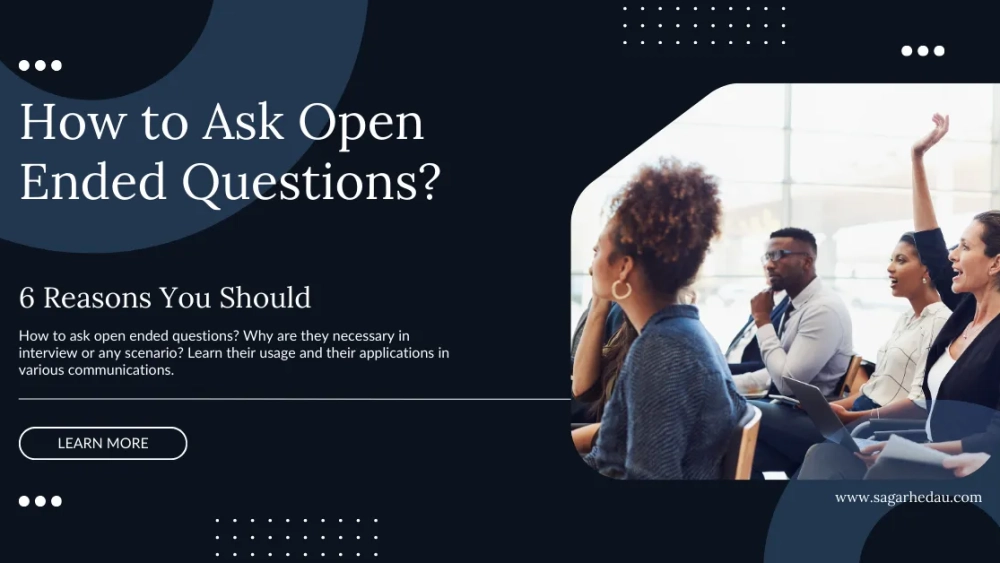Have you ever found yourself in a conversation that feels more like an interrogation than a dialogue? Or perhaps you’ve struggled to get meaningful responses from your team during a brainstorming session? The art of asking open-ended questions might be the solution you’re looking for.
These powerful tools can transform your communication, deepen your understanding, and unlock a wealth of information you might otherwise miss. In this blog post, we will discuss how to ask open ended questions, equipping you with the skills to foster more engaging and productive conversations in both your personal and professional life.
How to ask open ended questions and their benefits
- Encourage deeper thinking: Open-ended questions prompt individuals to think more critically and analytically about a topic. Unlike closed-ended questions that often require a simple “yes” or “no” answer, open-ended questions encourage people to explore their thoughts, feelings, and opinions in greater depth. This process of reflection can lead to new insights, more creative solutions, and a better understanding of complex issues.
- Facilitate better conversations: Open-ended questions naturally lead to more engaging and meaningful dialogues. They invite elaboration and discussion, allowing conversations to flow more naturally and cover a wider range of topics. This type of questioning creates an environment where people feel more comfortable sharing their ideas and perspectives, leading to richer, more dynamic exchanges. It also helps build rapport and trust between conversational partners, as it shows genuine interest in the other person’s thoughts and experiences.
- Gather more detailed information: When you ask open-ended questions, you’re likely to receive more comprehensive and nuanced responses. These questions allow respondents to provide context, explain their reasoning, and offer examples to support their points. This wealth of information can be particularly valuable in various scenarios, such as:
- In research, where detailed responses can provide qualitative data that offers deeper insights than quantitative data alone.
- In problem-solving situations, where understanding the full context and nuances of an issue is crucial to finding an effective solution.
- In customer feedback scenarios, where detailed responses can highlight specific areas for improvement or innovation.
Types of Open Ended Questions
- Exploratory questions: These questions are designed to gather information and discover new ideas. They help you understand a topic more broadly or deeply. Exploratory questions often start with “What,” “How,” or “Why.”
- “What factors do you think contribute to this problem?”
- “How does this process typically work in your organization?”
- “Why do you think this trend is emerging in our industry?”
- Clarifying questions: These questions help you better understand what someone has said or to get more specific information. They’re useful for filling in gaps in your understanding or for getting more precise details.
- “Can you elaborate on what you mean by ‘efficient process’?”
- “What specifically do you mean when you say it’s ‘not working’?”
- “Could you give me an example of when this has happened?”
- Hypothetical questions: These questions ask people to imagine different scenarios or possibilities. They’re great for problem-solving, creative thinking, and understanding someone’s decision-making process.
- “If budget wasn’t a constraint, how would you approach this project?”
- “What would you do if you encountered this situation in the future?”
- “How might this policy change affect our operations in five years?”
- Reflective questions: These questions encourage people to think about their experiences, feelings, or opinions. They’re particularly useful for promoting self-awareness, learning from experiences, and understanding motivations.
- “How did you feel when you received that feedback?”
- “What have you learned from this experience?”
- “In what ways has this project changed your perspective on our industry?”
Each type of open-ended question serves a different purpose and can be particularly effective in certain situations. Using a mix of these question types can lead to more comprehensive and insightful conversations.
Tips for Crafting Effective Open-Ended Questions
Crafting effective open-ended questions is a skill that can significantly enhance your ability to gather information, stimulate thoughtful discussions, and gain deeper insights. While the concept might seem straightforward, there are specific techniques you can employ to make your questions more powerful and engaging.
Let’s explore these tips for crafting effective open-ended questions:
- Start with “how,” “what,” or “why”: These question starters naturally lead to more detailed responses. They prompt the respondent to explain, describe, or reason, rather than give a short, closed answer.
Examples:
- “How did you arrive at this conclusion?”
- “What factors influenced your decision?”
- “Why do you think this approach would be effective?”
- Avoid yes/no structures: Questions that can be answered with a simple “yes” or “no” often fail to elicit detailed information. Restructure these questions to encourage more elaborate responses.
Instead of: “Did you like the presentation?” Try: “What aspects of the presentation stood out to you?”
- Keep questions simple and focused: Avoid compound questions or overly complex language. Simple, straightforward questions are easier to understand and answer.
Example of a complex question: “Can you describe the project timeline, budget constraints, and team dynamics, and how they all interacted to affect the final outcome?”
Better approach: Break it down into simpler, focused questions:
- “How did the project timeline affect the outcome?”
- “What role did budget constraints play in the project?”
- “How did team dynamics influence the final result?”
- Use neutral language: Avoid leading questions or loaded language that might bias the response. Neutral language allows the respondent to express their own views freely.
Instead of: “Don’t you think the new policy is unfair?” Try: “What are your thoughts on the new policy?”
Common Mistakes to Avoid When Asking Open-Ended Questions
Leading Questions:
- Definition: A question that suggests or implies a particular answer.
- Example: “Don’t you think the new policy is unfair?”
- Why it’s bad: It biases the respondent towards a specific answer, limiting their freedom to express their true thoughts.
Multiple Questions at Once:
- Definition: Asking more than one question in a single sentence.
- Example: “Did you enjoy the movie, and what did you think of the acting?”
- Why it’s bad: It can confuse the respondent and lead to incomplete or inaccurate answers.
Overly Complex or Vague Questions:
- Definition: Questions that are difficult to understand or require too much information to answer effectively.
- Example: “What are your thoughts on the socioeconomic implications of climate change?”
- Why it’s bad: It can discourage the respondent from answering or lead to irrelevant or off-topic responses.
To avoid these mistakes and encourage open-ended responses:
- Keep it simple: Ask questions that are easy to understand and require a straightforward answer.
- Be specific: Avoid vague or general questions that can lead to confusion.
- Use open-ended prompts: Start questions with “how,” “what,” “why,” or “could you tell me more about…” to encourage detailed and thoughtful responses.
- Avoid leading language: Phrase your questions in a neutral way that doesn’t suggest a particular answer.
- Listen actively: Pay attention to the respondent’s answers and ask follow-up questions to keep the conversation going.
Practice Techniques for Asking Open-Ended Questions
Role-Playing Exercises
- Scenario creation: Develop various scenarios where you need to ask open-ended questions. For example, a job interview, a customer service interaction, or a casual conversation with a friend.
- Role assignment: Assign roles to participants and have them act out the scenario, focusing on using open-ended questions.
- Feedback and improvement: After the role-play, provide feedback on the quality of the questions asked and discuss ways to improve them.
Question Reframing Activities
- Question analysis: Provide participants with a list of closed-ended questions and ask them to reframe them into open-ended ones.
- Group discussion: Facilitate a discussion about the effectiveness of the reframed questions and the benefits of using open-ended questions in different situations.
- Peer review: Have participants exchange their reframed questions and provide feedback on their clarity and openness.
Active Listening Drills
- Shadowing: Have participants repeat the words of a speaker or recording verbatim to improve their listening skills and concentration.
- Paraphrasing: Ask participants to summarize the main points of a conversation or speech in their own words.
- Empathic listening: Practice responding to statements with empathetic phrases like “It sounds like you’re feeling…” or “I can understand why you might think that.”
How to Ask Open Ended Questions in the Real World?
Open-ended questions are essential tools for fostering deeper understanding, building relationships, and gathering valuable information. They encourage thoughtful responses, promote engagement, and can be used in various settings, from personal interactions to professional environments.
Here are some examples of open-ended questions that encourage detailed and thoughtful responses:
General Questions
- What are your thoughts on…?
- How do you feel about…?
- Could you tell me more about…?
- What are your experiences with…?
- Can you describe a time when…?
Relationship Questions
- What do you value most in a friendship?
- How do you define a healthy relationship?
- What are your biggest challenges in your relationship?
- What are your goals for your relationship in the future?
Work and Career Questions
- What motivates you in your work?
- What are your career aspirations?
- How do you handle challenges in your workplace?
- What do you find most rewarding about your job?
Personal Questions
- What is your biggest dream in life?
- What are you most proud of?
- What are your biggest fears or insecurities?
- What do you consider your greatest strength?
Conclusion
How to ask open ended questions? Mastering this art is a valuable skill that can significantly enhance your communication in all areas of life. By encouraging deeper thinking, facilitating better conversations, and gathering more detailed information, open-ended questions can lead to richer insights and stronger connections.
Remember, the key lies in practice and mindfulness. Start with simple techniques like beginning your questions with “how,” “what,” or “why,” and gradually refine your approach. As you become more adept at crafting and using open-ended questions, you’ll likely notice a positive shift in the quality of your interactions.
Whether you’re an educator, a professional, or simply someone looking to improve your personal relationships, the power of open-ended questions is now in your hands. So go forth, ask thoughtfully, and prepare to be amazed by the depth and breadth of responses you’ll receive.

